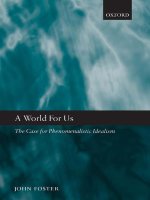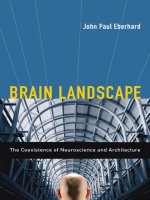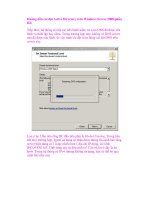BANGKOK dec 2008 ECOTOXICOLOGY III FINAL + QUESTIONS
Bạn đang xem bản rút gọn của tài liệu. Xem và tải ngay bản đầy đủ của tài liệu tại đây (137.26 KB, 21 trang )
Bangkok Ecotoxicology III p.1
ECOTOXICOLOGY:
Toxicity testing for environmental effects
and their endpoints
Bangkok Ecotoxicology III p.2
Ecological risk assessment: exposure and effects
assessment
risk
chemical
environmental fate
concentration in
a certain compartment
PEC
no-effect concentration
in a compartment
PNEC
effects at ecosystem
level
objective of ecological risk assessment: supply information to
protect our environment for adverse effects of chemicals
Bangkok Ecotoxicology III p.3
Ecotoxicity
Topics
Test systems
Modifying factors
Sensitivity of organisms
Bangkok Ecotoxicology III p.4
Effects of chemicals in the environment
direct effects:
• mortality
• inhibition of growth
• inhibition of reproduction
single species
indirect effects:
• food webs
• avoidance
• disturbance of processes
ecosystem level
Bangkok Ecotoxicology III p.5
Test systems used in ecological risk assessment
single species tests: acute effects (mortality)
single species tests: semi-chronic, sublethal effects
single species test with effect at population dynamics
microcosms
ecosystems
Bangkok Ecotoxicology III p.6
Acute test with Daphnia and fish
duration: 2-4 days
effects: survival
test systems: static, daily renewal
Bangkok Ecotoxicology III p.7
Semi-chronic tests with algae, Daphnia and fish
duration: 4, 15, 32 days
effects: survival, growth, reproduction, outcome of eggs,
development, behaviour
test systems: static, daily renewal or flow through
Example: early life stage test with fish (ELS test)
Bangkok Ecotoxicology III p.8
Question
What endpoints do you consider most relevant for
ecotoxicological risk assessment?
What endpoints would you suggest for top predators in
ecosystems?
What is a significant difference between human and
ecotoxicological risk assessment?
Bangkok Ecotoxicology III p.9
Test systems
system:
in vivo (whole organisms)
or in vitro (cells, protein)
dosing systems:
static
daily renewal
flow through system (continuous renewal)
Bangkok Ecotoxicology III p.10
Test system: concentration of chemicals
problems:
decrease of concentration during test
making “good” test solutions for:
low soluble or
low boiling test chemicals
from van Leeuwen and Hermens, 1995: Risk Assessment of Chemicals
Chapter 6 (van Leeuwen)
Flow-through
Renewal
Static
Flow-through
Renewal
Static
Time (h)
Log concentration in water (mg/L)
Fish
Water
Log concentration in fish (mg/kg)
Bangkok Ecotoxicology III p.11
Modifying factors
Toxicity (effect concentration) may depend on:
exposure duration
environmental parameters:
pH
hardness
oxygen concentration
presence of suspended particles
Bangkok Ecotoxicology III p.12
Influence of exposure time on effect concentration
Reaching steady state will depend on:
- kinetic behavior
- other phenomena
from van Leeuwen and Hermens, 1995: Risk Assessment of Chemicals
Chapter 6 (van Leeuwen)
LC
50
LC
50
Time (d)
1234
A
B
Bangkok Ecotoxicology III p.13
Influence of pH on effect concentration
Bioavailability of heavy metals in soil
from van Leeuwen and Hermens, 1995: Risk Assessment of Chemicals
Chapter 6 (van Leeuwen)
1200
1000
800
600
400
200
0
3.5 4.0 4.5 5.0 5.5 6.0 6.5
p
H soil
Lead
Cadmium
Relative bioavailability (
%
)
Bangkok Ecotoxicology III p.14
Influence of hardness on LC50 in rainbow trout
from van Leeuwen and Hermens, 1995: Risk Assessment of Chemicals
Chapter 6 (van Leeuwen)
100
50
20
10
5
2
1
0.5
0.2
0.1
0.05
0.02
0.01
Nickel
Zinc
Lead
Cadmium
Copper
10 20 50 100 200 500
Total hardness (mg/L CaCO )
3
48-h LC50 (mg of metal/L)
Bangkok Ecotoxicology III p.15
Speciation of aluminium as a function of pH
Speciation of
heavy metals depends on:
pH
hardness
salinity
from van Leeuwen and Hermens, 1995: Risk Assessment of Chemicals
Chapter 6 (van Leeuwen)
1.0
0.8
0.6
0.4
0.2
0.0
4.0 4.5 5.0 5.5 6.0 6.5 7.0 7.53.5
Al fraction
Al
3+
A
l(OH)
+
2
A
l(OH)
-
4
AlSO
+
4
AlOH
2+
Water pH
Bangkok Ecotoxicology III p.16
Influence of organic carbon content on bioavailability
48-h LC50 of kepone
to the midge larve
LC50 based on
concentration in:
- interstitial water
- sediment
from van Leeuwen and Hermens, 1995: Risk Assessment of Chemicals
Chapter 6 (van Leeuwen)
1.0
0.9
0.8
0.7
0.6
0.5
0.4
0.3
0.2
0.1
0
30
25
20
15
10
5
0
1.0 1.5 2.00.50
Sediment
Water
Sediment organic carbon content (%)
48-h LC Based on sedi
m
ent interstitial
50
water kepone concentration (mg/L)
48-h LC Based on sediment
50
kepone concentration (mg/kg)
Bangkok Ecotoxicology III p.17
Differences in sensitivity
LC50 (mg/L) 1,3,5-
trimethylbenzene
chlorothion
Daphnia 4.4 0.0062
Guppy 5.8 0.192
A
lgae 2.7
Pond snail 1.3
Midge larvae 0.031
- Organisms have different sensitivities to a chemical substance
- Variation in sensitivity strongly depends on mode of action
data from Verhaar, 1991 and Legierse, 1997
Bangkok Ecotoxicology III p.18
1,3,5-trimethylbenzene versus chlorothion
oxidation
(NADPH)
de-alkylation
GSH
O
P=S
OCH
3
OCH
3
NO
2
Cl
O
P=S
OH
OCH
3
NO
2
Cl
O
P=O
OCH
3
OCH
3
NO
2
Cl
specific mode of action:
inhibition of Acetylcholin-esterase
by oxon metabolite
chlorothion:
interaction with a receptor
of an active metabolite
1,3,5-trimethylbenzene:
non specific mode of
action in acute tests
Bangkok Ecotoxicology III p.19
Reasons for differences in sensitivity
Environmental factors (external)
pH, hardness, salinity, suspended particles
experimental artifacts ?
Internal factors
uptake / accumulation kinetics
biotransformation capacity (in case of bio-activation)
presence of target (example: neurotoxicants, herbicides)
sensitivity of the target or receptor
Bangkok Ecotoxicology III p.20
Setting safe concentrations at the ecosystem level
Impossible to test many different species
number of different protozoa: 30.000
number of different crustaceans: 25.000
In practice: data for 3-6 test organisms
How to set safe concentrations:
- use of application factors
- use of extrapolation techniques
Bangkok Ecotoxicology III p.21
Extrapolation techniques
Assumption:
certain distribution for
differences in sensitivity
- triangular
-normal
- logistic
Kooijman, van Straalen,
Wagner and Lokke, Aldenberg and Slob
from van Leeuwen and Hermens, 1995: Risk Assessment of Chemicals
Chapter 6 (van Leeuwen)
0.50
0.40
0.30
0.20
0.10
0
01234-4 -3 -2 -1
Number of standard deviations
Probability
Bangkok Ecotoxicology III p.22
Extrapolation technique: logistic distribution to calculate
HC5
HC5:
hazerdous concentration
for 5 % of the species
chosen as safe concentration
at ecosystem level
input:
NOECs for at least 5 species
from van Leeuwen and Hermens, 1995: Risk Assessment of Chemicals
Chapter 6 (van Leeuwen)
Extrapolation
Uncertainty
Log NOEC
Log HCp Log NOEC
p%
Number of species
Mean
Bangkok Ecotoxicology III p.23
Extrapolation techniques
Strengths and weaknesses:
- Assumption of certain distribution
which is not valid for several
chemicals (example: specific mode
of action)
- Certain organisms are key species
- Takes into account that differences
in sensitivity depend on the chemical
(mode of action)
from van Leeuwen and Hermens, 1995: Risk Assessment of Chemicals
Chapter 6 (van Leeuwen)
Log NOEC
Nu
m
ber o
f
species
Bangkok Ecotoxicology III p.24
ECOTOXICOLOGY:
Estimation methods in ecotoxicology
Bangkok Ecotoxicology III p.25
Activity of a chemical depends on:
Cl
Cl
Cl
Cl
OH
tetrachlorobiphenyl
methanol
hydrophobicity / solubility in water
size
electronic parameters: charge
Bangkok Ecotoxicology III p.26
Quantitative structure-activity relationship: properties
Hydrophobic parameters
A
queous solubility
Octanol-water partition coefficient (K
ow
)
Total Surface Area (TSA)
Total Molecular Volume (TMV)
Electronic parameters
A
tomic charges (q)
Energy of molecular orbitals (Elumo or Ehomo)
Delocalizability (D)
Hardness (n)
Hammett sigma substituent constants (s)
Reduction potential (E1/2)
Steric parameters
Total Surface Area (TSA)
Total Molecular Volume (TMV)
Taft substituent constant (Es)
Bangkok Ecotoxicology III p.27
Question
Which chemical or environmental properties do you consider to
be most important for environmental occurrence of the following
compounds?
1. Chlorinated biphenyls (PCBs)
2. Organophospate esters (e.g. parathion)
3. Pyrethroids (e.g. permethrin)
4. Mercury
Bangkok Ecotoxicology III p.28
Prediction of fate and effects via quantitative structure-
activity relationships (QSARs)
biodegradation rates
no-effect concentrations
soil sorption
bioaccumulation
quantitative model relating Y to X (QSAR)
Y = f (X)
prediction of fate or effect properties
from chemical structure for related chemicals
Cl
O
O
Cl
OH
Cl
chemical structure or properties
X
fate or effect properties
Y
Bangkok Ecotoxicology III p.29
QSAR for ecotoxicity
bioconcentration / partitioning
effect concentrations
endocrine disruption
Bangkok Ecotoxicology III p.30
Bioconcentration
uptake via food or particles
uptake via gills (aqueous phase)
time
concentration in fish
concentration in water
bioconcentration factor in fish (BCF)
BCF = C
f
/ C
a
Bangkok Ecotoxicology III p.31
2
3
4
5
23456
log Kow
log BCF
Uptake: bioconcentration in fish
several chemcials
bioconcentrate less than predicted
due to biotransformation
models are developed for relatively
simple chemicals:
• no biotransformation
• uptake only via aqueous phase
Relation between bioconcentration factors and
octanol-water partition coefficeints (K
ow
)
Bangkok Ecotoxicology III p.32
Question
Can explain what other possible reasons there could be
(besides biotransformation) that causes deviation from the
observed QSAR ?
Think of at least two groups of compounds that might deviate
from this QSAR due to the effect of biotransformation
Bangkok Ecotoxicology III p.33
Prediction of ecotoxicity
Four classes in acute toxicity
class 1: chemicals with base-line toxicity (non-polar narcosis)
class 2: chemicals that act by polar narcosis
class 3: alkylating agents (reactive towards nucleophiles: SH,
OH, NH) leading to cytotoxicity, membrane irritation,
mutagenicity or carcinogenicity
class 4: chemicals with specific modes of action
Verhaar, 1992 / Veith, 1990 / Bradbury, 1990 / Hermens, 1989
Bangkok Ecotoxicology III p.34
-1
0
1
2
3
4
5
6
-20246
log Kow
log LC50
Class 1: chemicals that act by narcosis
LC50 to fish
Cl
Cl
Cl
CH
3
Cl
O
OH
alcohols, ethers,
(chorinated) aromatic hydrocarbons
data from Könemann, 1981
Bangkok Ecotoxicology III p.35
Class 1: chemicals that act by narcosis
NOEC early life stage test (reproduction, growth)
data from Call, 1985 / van Leeuwen, 1990
-1
0
1
2
3
4
5
6
-20246
log Kow
log C (umol/L)
LC50
NOEC: early life stage test
Bangkok Ecotoxicology III p.36
Narcosis
cel membrane
phospholipids
sodium channel
(protein)
phospholipids
sodium channel
(protein) is blocked
xenobiotics
blocking of protein channel: disturbance of transport of nerve impulses
narcosis
Bangkok Ecotoxicology III p.37
-1
0
1
2
3
4
5
6
-20246
log Kow
log LC50
Class 2: chemicals that act by polar narcosis
NH
2
CH
3
Cl
NH
2
OH
OH
Cl
OH
CH
3
N
+
O
O
N
+
O
O
CH
3
N
+
O
O
Cl
NH
2
anilines, phenols and nitroaromatics
data from Könemann, 1981 / Hermens, 1984 / Deneer, 1987
Bangkok Ecotoxicology III p.38
Reactive chemicals
Examples: epoxides, aldehydes, unsaturated chorinated hydrocarbons
These chemicals may react with nucleophiles (NH, OH and SH)
in for example DNA, proteins, glutathion, leading to:
irritation
cytoxiciity
DNA damage (carcinogens, mutagens)
more toxic than narcosis
Bangkok Ecotoxicology III p.39
-1
0
1
2
3
4
5
6
-2 0 2 4 6
log Kow
log LC50
Class 3: reactive chemicals
aldehydes
epoxides
benzylic chlorides
allylchloride
O
Cl
O
O
CH
2
Cl
Cl
Br
I
O
epoxides, unsaturated
chlorohydrocarbons, aldehydes, etc.
data from Hermens, 1985 / Deneer, 1988
Bangkok Ecotoxicology III p.40
Class 4: chemicals with a specific mode of action
-3
-2
-1
0
1
2
3
4
5
6
-20246
log Kow
log LC50
DDT
lindane
pentachlorophemol
organophosphates
Cl
Cl
Cl
Cl
Cl
Cl
CCl
3
Cl
Cl
OH
Cl
Cl
Cl
Cl
Cl
O
P=S
OCH
3
OCH
3
data from Hermens, 1982 / De Bruijn, 1992
Bangkok Ecotoxicology III p.41
Chemical domain of models: example
Acute toxicity to fish:
log K
ow
LC50
(mol/L)
1-chloro-2,4-dinitrobenzene 2.20 6.5 10
-7
3,5-dichloro-nitrobenzene 3.20 2.3 10
-5
1-chloro-2,4-dinitrobenzene alkylating agent
3,5-dichloro-nitrobenzene “polar narcotic”
Bangkok Ecotoxicology III p.42
Application of QSARs
predictions of effect concentration for risk assessment
classifying chemicals into “mode of action” classes (100.000
chemicals on EINECS)
mechanistic studies (receptor mediated effects)
priority setting
evaluation of effects of mixtures









